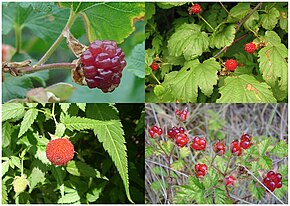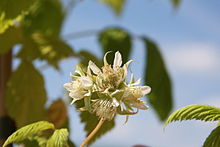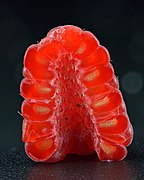Raspberry


Theraspberryis the edible fruit of a multitude of plantspeciesin thegenusRubusof therose family,most of which are in thesubgenusIdaeobatus.[1]The name also applies to these plants themselves. Raspberries areperennialwithwoody stems.[2]
World production of raspberries in 2022 was 947,852tonnes,led by Russia with 22% of the total. Raspberries are cultivated across northern Europe and North America and are consumed in various ways, including as whole fruit and inpreserves,cakes, ice cream, andliqueurs.[3]Raspberries are a rich source ofvitamin C,manganese,anddietary fiber.
Description[edit]
A raspberry is anaggregate fruit,developing from the numerous distinct carpels of a single flower.[4]What distinguishes the raspberry from itsblackberryrelatives is whether or not the torus (receptacleor stem) "picks with" (i.e., stays with) the fruit. When picking a blackberry fruit, the torus stays with the fruit. With a raspberry, the torus remains on the plant, leaving a hollow core in the raspberry fruit.[5]
Raspberries are grown for the fresh fruit market and for commercial processing intoindividually quick frozen(IQF) fruit,purée,juice, ordried fruitused in a variety of grocery products such asraspberry pie.Raspberries need ample sun and water for optimal development. Raspberries thrive in well-drained soil with a pH between 6 and 7 with ample organic matter to assist in retaining water.[6]While moisture is essential, wet and heavy soils or excessirrigationcan bring onPhytophthoraroot rot, which is one of the most serious pest problems facing the red raspberry. As a cultivated plant in moist, temperate regions, it is easy to grow and tends to spread unless pruned. Escaped raspberries frequently appear as garden weeds, spread by seeds found in bird droppings.[citation needed]
An individual raspberry weighs 3–5 g (0.11–0.18 oz) and is made up of around 100drupelets,[7]each of which consists of a juicy pulp and a single central seed. A raspberry bush can yield several hundred berries a year.
-
Halved raspberry, torus does not remain when the fruit is picked
-
Halved blackberry, torus remains when the fruit is picked
Etymology[edit]
Raspberry derives its name fromraspise,"a sweet rose-colored wine" (mid-15th century), from theAnglo-Latinvinum raspeys,or fromraspoie,meaning "thicket", of Germanic origin.[8]The name may have been influenced by its appearance as having a rough surface, related to the Old Englishraspor "rough berry".[8]
Species[edit]


Examples of raspberry species inRubussubgenusIdaeobatusinclude:
- Rubus crataegifolius(Asian raspberry)
- Rubus gunnianus(Tasmanian alpine raspberry)
- Rubus idaeus(red raspberry or European red raspberry)
- Rubus leucodermis(whitebark raspberry or western raspberry, blue raspberry, black raspberry)
- Rubus occidentalis(black raspberry)
- Rubus parvifolius(Australian native raspberry)
- Rubus phoenicolasius(wine raspberry or wineberry)
- Rubus rosifolius(Mauritius raspberry)
- Rubus strigosus(American red raspberry) (syn.R. idaeusvar.strigosus)
- Rubus ellipticus(yellow Himalayan raspberry)
Several species ofRubus,also called raspberries, are classified in other subgenera, including:
- Rubus deliciosus(boulder raspberry, subgenusAnoplobatus)
- Rubus odoratus(flowering raspberry, subgenusAnoplobatus)
- Rubus nivalis(snow raspberry, subgenusChamaebatus)
- Rubus arcticus(Arctic raspberry, subgenusCyclactis)
- Rubus sieboldii(Molucca raspberry, subgenusMalachobatus)
Cultivation[edit]

Various kinds of raspberries can be cultivated fromhardiness zones3 to 9.[9]Raspberries are traditionally planted in the winter as dormant canes, although planting of tender, plug plants produced by tissue culture has become much more common. A specialized production system called "long cane production" involves growing canes for a year in a northern climate such as Scotland orOregonorWashington,where the chilling requirement for proper bud break is attained, or attained earlier than the ultimate place of planting. These canes are then dug, roots and all, to be replanted in warmer climates such as Spain, where they quickly flower and produce a very early season crop. Plants are typically planted 2–6 per m in fertile, well drained soil; raspberries are usually planted in raised beds/ridges, if there is any question about root rot problems.[citation needed]
All cultivars of raspberries have perennial roots, but many do not have perennial shoots. In fact, most raspberries have shoots that arebiennial(meaning shoots grow in the first growing season and fruits grow on those shoots during the second growing season).[10]The flowers can be a majornectar sourceforhoneybeesand other pollinators.[citation needed]
Raspberries are vigorous and can be locally invasive. They propagate usingbasal shoots(also known as suckers), extended underground shoots that develop roots and individual plants. They can sucker new canes some distance from the main plant. For this reason, raspberries spread well, and can take over gardens if left unchecked. Raspberries are often propagated using cuttings, and will root readily in moist soil conditions.
The fruit is harvested when it comes off the receptacle easily and has turned a deep color (red, black, purple, or golden yellow, depending on the species and cultivar). This is when the fruits are ripest and sweetest.
High tunnel bramble production offers the opportunity to bridge gaps in availability during late fall and late spring. Furthermore, high tunnels allow less hardy floricane-fruiting raspberries to overwinter in climates where they would not otherwise survive. In the tunnel, plants are established at close spacing usually prior to tunnel construction.[11]
Cultivars[edit]
Major cultivars[edit]

Raspberries are an important commercial fruit crop, widely grown in all temperate regions of the world. Many of the most important modern commercial red raspberrycultivarsderive fromhybridsbetweenR. idaeusandR. strigosus.[9]Some botanists consider the Eurasian and American red raspberries to belong to a single, circumboreal species,Rubus idaeus,with the European plants then classified as eitherR. idaeussubsp.idaeusorR. idaeusvar.idaeus,and the native North American red raspberries classified as eitherR. idaeussubsp.strigosus,orR. idaeusvar.strigosus.Recent breeding has resulted incultivarsthat are thornless and more strongly upright, not needing staking.[citation needed]
The black raspberry,Rubus occidentalis,is also cultivated, providing both fresh and frozen fruit, as well as jams, preserves, and other products, all with that species' distinctive flavor.
Purple raspberries have been produced by horticultural hybridization of red and black raspberries, and have also been found in the wild in a few places (for example, inVermont) where the American red and the black raspberries both grow naturally. Commercial production of purple-fruited raspberries is rare.
Blue raspberryis a local name used inPrince Edward County, Ontario,Canada,[12]for the cultivar 'Columbian', a hybrid (purple raspberry) ofR. strigosusandR. occidentalis.[13]Blue raspberrycan also refer to the whitebark raspberry,R. leucodermis.[citation needed]
Fruits from such plants are called golden raspberries or yellow raspberries; despite their similar appearance, they retain the distinctive flavor of their respective species (red or black). Most pale-fruited raspberries commercially sold in the eastern United States are derivatives of red raspberries. Yellow-fruited variants of the black raspberry are sometimes grown in home gardens.
Red raspberries have also been crossed with various species in other subgenera of the genusRubus,resulting in a number ofhybrids,the first of which was theloganberry.Later notable hybrids include theolallieberry,boysenberry,marionberry,andtayberry;all are multi-generational hybrids. Hybridization between the familiar cultivated red raspberries and a few Asiatic species ofRubushas also been achieved.
Selected cultivars[edit]
Numerous raspberrycultivarshave been selected.
Two types of raspberry are available for commercial and domestic cultivation; the summer-bearing type produces an abundance of fruit on second-year canes (floricanes) within a relatively short period in midsummer, and double or "everbearing" plants, which also bear some fruit on first-year canes (primocanes) in the late summer and fall, as well as the summer crop on second-year canes. Those marked (AGM) have gained theRoyal Horticultural Society'sAward of Garden Merit.
Red, early Summer fruiting[edit]
Red, Mid-summer Fruiting[edit]
- Cuthbert
- Glen Ample (AGM)[17]
- Lloyd George
- Meeker
- Newburgh
- Ripley
- Skeena
- Cowichan
- Chemainus
- Saanich
Red, Late Summer Fruiting[edit]
Red primocane, Autumn fruiting[edit]
Yellow primocane, Autumn fruiting[edit]
- Anne
- Fallgold
- Fertödi Aranyfürt
- Goldenwest
- Golden Queen
- Honey Queen
- Jambo
- Kiwi Gold
Purple (hybrids betweenblackandred raspberries)[edit]
- Brandywine
- Glencoe
- Royalty
Black[edit]
- Black Hawk
- Bristol
- Cumberland
- Jewel
- Logan
- Morrison
- Munger
- Ohio Everbearer
- Scepter
Dwarf cultivars[edit]
- Ruby Beauty= 'Nr7'[25]
Diseases and pests[edit]
Raspberries are sometimes eaten by thelarvaeof someLepidopteraspecies (butterflies and moths). More serious are theraspberry beetle(in Europe)[26]and theraspberry fruitworm(in North America),[27]whose larvae can damage raspberries.
Botrytis cinerea,or gray mold, is a common fungal infection of raspberries and other soft fruit under wet conditions. It is seen as a gray mold growing on the raspberries, and particularly affects fruit which are bruised, as the bruises provide an easy entrance point for the spores.
Raspberry plants should not be planted where potatoes, tomatoes, peppers, eggplants, or bulbs have previously been grown, without prior fumigation of the soil. These crops are hosts for the diseaseVerticilliumwilt,a fungus that can stay in the soil for many years and can infest the raspberry crop.
Animals[edit]
Raspberries, among other plants with high sugar content like peaches, are prime targets for theJapanese beetle,which relies heavily on these sources as its main food resource. The voracious feeding habits of Japanese beetles not only pose a direct threat to raspberry plants but also increase the risk of transmitting various plant diseases. This dual impact can significantly undermine agricultural productivity, making it crucial for raspberry growers to implement effective pest management strategies to mitigate the damage caused by Japanese beetle infestations.[28][29]
Production[edit]
| 212 | |
| 174 | |
| 116 | |
| 105 | |
| 76 | |
| World | 948 |
In 2022, world production of raspberries was 947,852tonnes,led byRussiawith 22% of the total (table). Other major producers wereMexico,Serbia,Poland,and theUnited States.
Nutrition[edit]
| Nutritional value per 100 g (3.5 oz) | |
|---|---|
| Energy | 220 kJ (53 kcal) |
11.94 g | |
| Sugars | 4.42 g |
| Dietary fiber | 6.5 g |
0.65 g | |
1.2 g | |
| Vitamins | Quantity %DV† |
| Thiamine (B1) | 3% 0.032 mg |
| Riboflavin (B2) | 3% 0.038 mg |
| Niacin (B3) | 4% 0.598 mg |
| Pantothenic acid (B5) | 7% 0.329 mg |
| Vitamin B6 | 3% 0.055 mg |
| Folate (B9) | 5% 21 μg |
| Choline | 2% 12.3 mg |
| Vitamin C | 29% 26.2 mg |
| Vitamin E | 6% 0.87 mg |
| Vitamin K | 7% 7.8 μg |
| Minerals | Quantity %DV† |
| Calcium | 2% 25 mg |
| Iron | 4% 0.69 mg |
| Magnesium | 5% 22 mg |
| Manganese | 29% 0.67 mg |
| Phosphorus | 2% 29 mg |
| Potassium | 5% 151 mg |
| Zinc | 4% 0.42 mg |
| Other constituents | Quantity |
| Water | 85.8 g |
| †Percentages estimated usingUS recommendationsfor adults,[31]except for potassium, which is estimated based on expert recommendation fromthe National Academies.[32] | |
Raw raspberries are 86% water, 12%carbohydrates,and have about 1% each ofproteinand fat (table). In a reference amount of 100 g (3.5 oz), raspberries supply 53kilocaloriesand 6.5 grams ofdietary fiber.Raspberries are a rich source (20% or more of theDaily Value,DV) ofvitamin C(32% DV),manganese(32% DV) and dietary fiber (26% DV), but otherwise have low content ofmicronutrients(table). Raspberries are a low-glycemic indexfood, with total sugar content of only 4% and nostarch.[33]
Theaggregate fruitstructure contributes to raspberry's nutritional value, as it increases the proportion of dietary fiber, which is among the highest known inwhole foods– up to 6% fiber per total weight.[33]
Phytochemicals[edit]
Raspberries containphytochemicals,such asanthocyaninpigments,ellagic acid,ellagitannins,quercetin,gallic acid,cyanidins,pelargonidins,catechins,kaempferolandsalicylic acid.[34][35]Yellow raspberries and others with pale-colored fruits are lower in anthocyanin content.[34]Both yellow and red raspberries contain carotenoids, mostly lutein esters, but these are masked by anthocyanins in red raspberries.[36]
Raspberry compounds are under preliminary research for their potential to affect human health.[37]
Leaves[edit]
Raspberry leaves can be used fresh or dried inherbal teas,providing an astringent flavor. Inherbalandtraditional medicine,raspberry leaves are used for some remedies, although there is no scientifically valid evidence to support their medicinal use.[38]
See also[edit]
 Food portal
Food portal- Blue raspberry flavor
- Chambord (liqueur)
- Framboise
- List of culinary fruits
- Raspberry ketone
- Raspberry juice
- Red raspberry leaf(herb)
- Thimbleberry
References[edit]
- ^Jules Janick (2011).Plant Breeding Reviews, Volume 32: Raspberry Breeding and Genetics.John Wiley & Sons. p. 51.ISBN9780470593813.
- ^George Bentham (1858).Handbook of the British Flora: A Description of Flowering Plants and Ferns Indigenous To, Or Naturalized In, the British Isles.Lovell Reeve. p. 189.
- ^"Raspberry | Description, Fruit, Cultivation, Types, & Facts".Encyclopedia Britannica.24 November 2023.Retrieved6 December2023.
- ^"Angiosperm - Petals, Stamens, Sepals".Encyclopedia Britannica.Retrieved6 December2023.
consist of several separate carpels of one apocarpous gynoecium (e.g., raspberries where each unit is a single carpel
- ^Gina Fernandez; Elena Garcia; David Lockwood."Fruit development".North Carolina State University, Cooperative Extension.Archivedfrom the original on 25 April 2019.Retrieved9 August2018.
- ^Strik, B.C. (2008)."Growing Raspberries in Your Home Garden".Growing Small Fruits.Oregon State University Extension Service.Archivedfrom the original on 26 January 2021.Retrieved23 October2021.
- ^Iannetta, P. P. M.; Wyman, M.; Neelam, A.; Jones, C.; Taylor, M. A.; Davies, H. V.; Sexton, R. (December 2000). "A causal role for ethylene and endo-beta-1,4-glucanase in the abscission of red-raspberry (Rubus idaeus) drupelets ".Physiologia Plantarum.110(4): 535–543.doi:10.1111/j.1399-3054.2000.1100417.x.
- ^ab"Raspberry".Online Etymology Dictionary. 2016.Archivedfrom the original on 23 October 2021.Retrieved23 October2021.
- ^abHuxley, A., ed. (1992).New RHS Dictionary of Gardening.MacmillanISBN0-333-47494-5.
- ^"Brambles (Fruit Production for the Home Gardener)".Fruit Production for the Home Gardener (Penn State Extension).Archivedfrom the original on 25 August 2017.Retrieved23 October2021.
- ^"High Tunnel Raspberries and Blackberries", Department of Horticulture publication, Cathy Heidenreich, Marvin Pritts, Mary Jo Kelly., and Kathy Demchak
- ^Woolfrey, Sandra Marshall.A Country Mouse with one paw in the Village:Growing up in Prince Edward County(PDF).Archived(PDF)from the original on 21 September 2013.Retrieved23 October2021.
- ^Hedrick, U.P.; Howe, G.H.; Taylor, O.M.; Berger, A.; Slate, G.L.; Einset, O. (1925).The small fruits of New York.Albany, New York: J. B. Lyon.Archivedfrom the original on 18 March 2012.Retrieved23 October2021.page 96
- ^"Rubus idaeus'Glen Moy'".RHS.Archivedfrom the original on 27 February 2021.Retrieved17 February2021.
- ^"Rubus idaeus'Malling Jewel'".RHS.Archivedfrom the original on 21 January 2021.Retrieved17 February2021.
- ^"Raspberry Plant Care".21 October 2021.Archivedfrom the original on 23 October 2021.Retrieved23 October2021.
- ^"Rubus idaeus'Glen Ample'".RHS.Archivedfrom the original on 4 March 2021.Retrieved17 February2021.
- ^"Rubus idaeus'Glen Magna'".RHS.Archivedfrom the original on 4 March 2021.Retrieved17 February2021.
- ^"Rubus idaeus'Leo'".RHS.Archivedfrom the original on 27 February 2021.Retrieved17 February2021.
- ^"Rubus idaeus'Malling Admiral'".RHS.Archivedfrom the original on 6 March 2021.Retrieved17 February2021.
- ^"Rubus idaeus'Tulameen'".RHS.Archivedfrom the original on 24 February 2021.Retrieved17 February2021.
- ^"Rubus idaeus'Autumn Bliss'".RHS.Archivedfrom the original on 27 February 2021.Retrieved17 February2021.
- ^"Rubus idaeus'Joan J'".RHS.Archivedfrom the original on 4 March 2021.Retrieved17 February2021.
- ^"Rubus idaeus'Polka'".RHS.Archivedfrom the original on 27 February 2021.Retrieved17 February2021.
- ^"Rubus idaeusRuby Beauty= 'Nr7'".RHS.Archivedfrom the original on 7 June 2021.Retrieved17 February2021.
- ^"Byturus tomentosus(BYTUTO)[World distribution] ".Global Database.European and Mediterranean Plant Protection Organization(EPPO). 1 July 2011.Archivedfrom the original on 30 April 2021.Retrieved28 April2021.
- ^"Raspberry Fruitworm Beetle (Byturus unicolor) ".iNaturalist.Archivedfrom the original on 24 July 2022.Retrieved28 April2021.
- ^"Japanese beetle - Popillia japonica".entnemdept.ufl.edu.Retrieved25 April2024.
- ^Klein, M (7 January 2022). Popillia japonica (Japanese beetle) (Report).doi:10.1079/cabicompendium.43599.
- ^FAOSTATof theUnited Nations"Production of raspberries in 2022; Pick lists by Crops/Regions/Production Quantity/Year".United Nations,Food and Agriculture Organization Corporate Statistical Database.2024.Retrieved29 May2024.
- ^United States Food and Drug Administration(2024)."Daily Value on the Nutrition and Supplement Facts Labels".FDA.Archivedfrom the original on 2024-03-27.Retrieved2024-03-28.
- ^National Academies of Sciences, Engineering, and Medicine; Health and Medicine Division; Food and Nutrition Board; Committee to Review the Dietary Reference Intakes for Sodium and Potassium (2019). Oria, Maria; Harrison, Meghan; Stallings, Virginia A. (eds.).Dietary Reference Intakes for Sodium and Potassium.The National Academies Collection: Reports funded by National Institutes of Health. Washington, DC: National Academies Press (US).ISBN978-0-309-48834-1.PMID30844154.Archivedfrom the original on 2024-05-09.Retrieved2024-06-21.
- ^ab"Nutrient data for raw raspberries, USDA Nutrient Database, SR-21".Conde Nast. 2014.Archivedfrom the original on 16 April 2014.Retrieved16 April2014.
- ^abCarvalho E, Franceschi P, Feller A, Palmieri L, Wehrens R, Martens S (2013). "A targeted metabolomics approach to understand differences in flavonoid biosynthesis in red and yellow raspberries".Plant Physiology and Biochemistry.72:79–86.Bibcode:2013PlPB...72...79C.doi:10.1016/j.plaphy.2013.04.001.PMID23622736.
- ^Mazur SP, Nes A, Wold AB, Remberg SF, Aaby K (2014). "Quality and chemical composition of ten red raspberry (Rubus idaeusL.) genotypes during three harvest seasons ".Food Chemistry.160:233–40.doi:10.1016/j.foodchem.2014.02.174.PMID24799233.
- ^Carvalho, Elisabete; Fraser, P.D.; Martens, S. (2013). "Carotenoids and tocopherols in yellow and red raspberries".Food Chemistry.139(1–4): 744–752.doi:10.1016/j.foodchem.2012.12.047.PMID23561169.
- ^Burton-Freeman, B. M.; Sandhu, A. K.; Edirisinghe, I (2016)."Red Raspberries and Their Bioactive Polyphenols: Cardiometabolic and Neuronal Health Links".Advances in Nutrition.7(1): 44–65.doi:10.3945/an.115.009639.PMC4717884.PMID26773014.
- ^Holst, Lone; Haavik, Svein; Nordeng, Hedvig (13 June 2009). "Raspberry leaf – Should it be recommended to pregnant women?".Complementary Therapies in Clinical Practice.15(4): 204–8.doi:10.1016/j.ctcp.2009.05.003.hdl:1956/3702.PMID19880082.
Further reading[edit]
- Funt, R.C.; Hall, H.K. (2012).Raspberries(Crop Production Science in Horticulture). CABI.ISBN978-1-84593-791-1.
External links[edit]
- .Encyclopædia Britannica.Vol. 22 (11th ed.). 1911.
- Raspberries & More(University of Illinois Extension)


